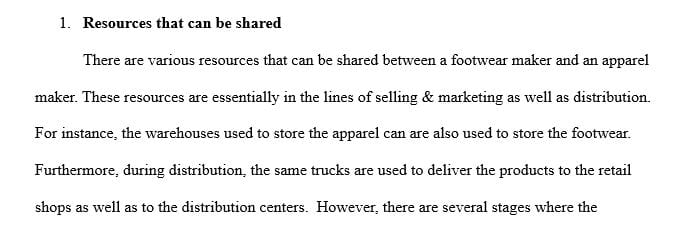What kinds of resources can likely be shared across different brands between an apparel maker and a footwear maker
Case analysis strategic management
Please answer these questions according to case analysis and case study (given later)
What kinds of resources can likely be shared across different brands between an apparel maker and a footwear maker? What kinds of resources are unlikely to be shared?
How much does being a larger, more diversified apparel and footwear company increase VF’s market power over its suppliers or customers? How could we assess how much this is worth?
If VF had increased its sales only by the amount of Timberland’s sales and had not reaped an increase in profitability, would you consider the acquisition successful?
How might you compare VF’s increase in profits to the premium it paid for Timberland?
Case Introduction
In June 2011, U.S.-based VF Corp., the global apparel and clothing maker, announced that it would acquire Timberland, the U.S.-based global footwear maker, for $2 billion, which was a 40% premium on Timberland’s stock price. VF is the maker of such established clothing brands as Lee and Wrangler Jeans, Nautica, lucy, 7 For All Mankind, Vans, Kipling, and outdoor apparel brands such as The North Face, JanSport, and Eagle Creek. Timberland is well known for its tough waterproof leather footwear, such as its bestselling, hiking, boots and its classic boat shoes; it also licenses the right to make clothing and accessories under its brand name. Obviously, Timberland’s stockholders were thrilled that they had made a 40% profit overnight on their investment; but why would a clothing maker purchase a footwear company that primarily competes in a different industry?
The reason, according to VF’s CEO Eric Wiseman, is that the Timberland deal would be a “transformative” acquisition that would add footwear to VF’s fastest-growing division, the outdoor and action sports business, which had achieved a 14% gain in revenues in 2010 and contributed $3.2 billion of VF’s total revenues of $7.7 billion. By combining the products of the clothing and footwear division, Wiseman claimed that VF could almost double Timberland’s profitability by increasing its global sales by at least 15%. At the same time, the addition of the Timberland brand would increase the sales of VF’s outdoor brands such as The North Face by 10%. The result would be a major increase in VF’s revenues and profitability—an argument its investors agreed with because, whereas the stock price of a company that acquires another company normally declines after the announcement, VF’s stock price soared by 10%.
Why would this merger of two very different companies result in so much more value being created? The first reason is that it would allow the company to offer an extended range of outdoor products—clothing, shoes, backpacks, and accessories—which could all be packaged together, distributed to retailers, and marketed and sold to customers. The result would be substantial cost savings because purchasing, distribution, and marketing costs would now be shared between the different brands or product lines in VF’s expanded portfolio. In addition, VF would be able to increasingly differentiate its outdoor products by, for example, linking its brand The North Face with the Timberland brand, so customers purchasing outdoor clothing would be more likely to purchase Timberland hiking boots and related accessories such as backpacks offered by VF’s other outdoor brands.
In addition, although Timberland is a well-known, popular brand in the United States, it generates more than 50% of its revenues from global sales (especially in high-growth markets such as China), and it has a niche presence in many countries such as the United Kingdom and Japan. In 2011, VF was only generating 30% of its revenues from global sales; by taking advantage of the commonalities between its outdoor brands, VF argued that purchasing Timberland would increase its sales in overseas markets and also increase the brand recognition and sales of its other primary brands such as Wrangler Jeans and Nautica. For example, hikers could wear VF’s Wrangler or Lee Jeans, as well as The North Face clothing, at the same time they put on their Timberland hiking boots. In short, Timberland’s global brand cachet and the synergies between the two companies’ outdoor-lifestyle products would result in major new value creation. Thus, the acquisition would allow VF to increase the differentiated appeal of all its brands, resulting in lower costs. VF would be able to negotiate better deals with specialist outsourcing companies abroad, and economies of scale would result from reduced global shipping and distribution costs.
In a conference call to analysts, Wiseman said that: “Timberland has been our Number 1 acquisition priority. It knits together two powerful companies into a new global player in the outdoor and action sports space.”
After the acquisition, the combined companies had more than 1,225 VF-operated retail stores, of which most were single-brand shops. VF also operated 80 U.S. outlet stores that sold a wide range of excess VF products. VF also sold to specialty stores, department stores, national chains, and mass merchants such as Wal-Mart (Wal-Mart accounted for 8% of VF’s total sales in 2012—primarily due to its purchases of jeanswear). The Timberland acquisition increased the range of products VF could distribute and sell through its many channels, resulting in synergies and cost savings. VF’s organizational structure leveraged the advantage of centralized purchasing, distribution, and IT to reduce costs across the organization.
Timberland’s 2010 sales (prior to the acquisition) had been $1.4 billion, and its net income had been $96 million—a net profit margin of just under 7%. VF’s sales in 2010 had been $7.7 billion with net income of $571 million, for a net profit margin of 7.4%. After the acquisition, VF Corporation posted revenues of $9.4 billion and $10.9 billion while also showing an increase in net profit margin to 9.4% and 10.0% in 2011 and 2012, respectively. Although it is difficult to know how much of these gains could be directly attributable to the Timberland acquisition, VF’s strategy of related diversification appeared to be paying off.
Sources: www.vfc.com and www.timberland.com.
Answer preview to what kinds of resources can likely be shared across different brands between an apparel maker and a footwear maker
APA
510 words



